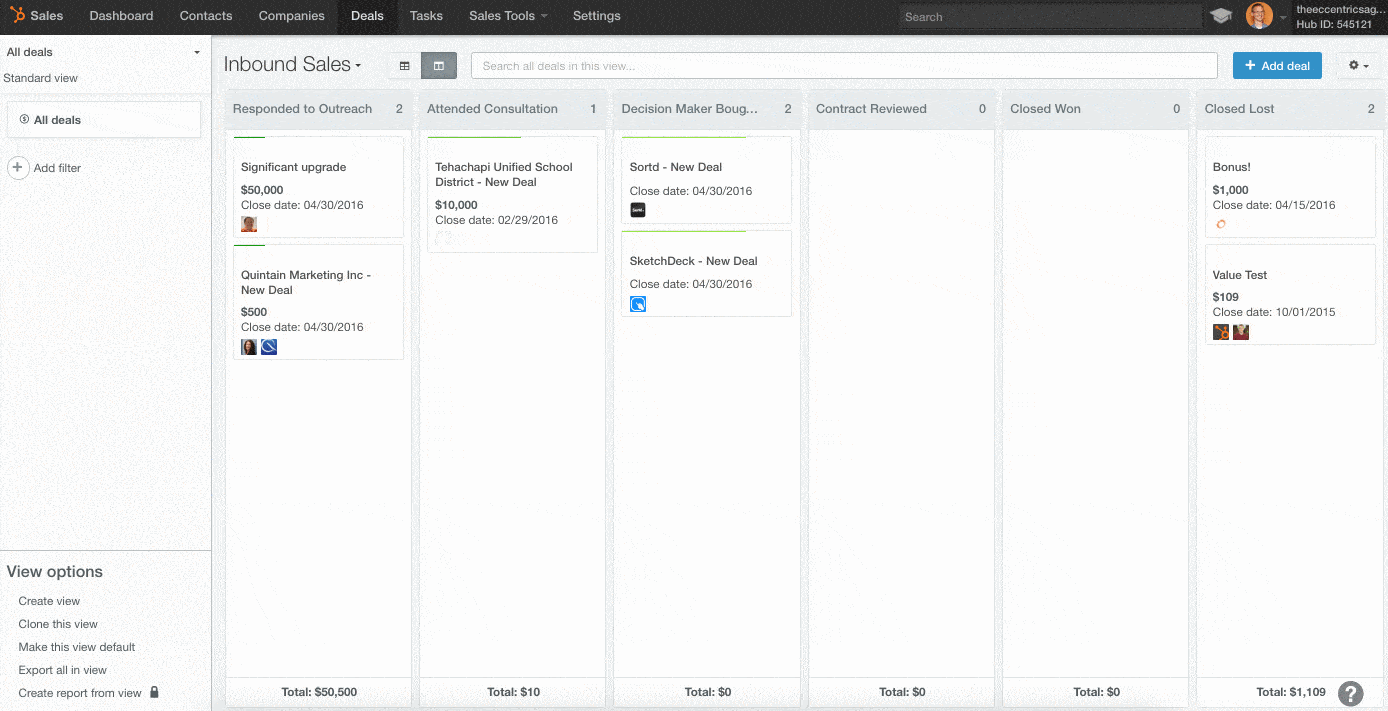Tips for improving sales performance with HubSpot pipeline tracking
If you manage a sales team, pipeline tracking is essential to keep tabs on progress and performance. But there's more to it than just setting up a spreadsheet and logging data. Here are some dos and don'ts of effective pipeline tracking, so you can make the most of this valuable tool.
What is pipeline tracking?
Pipeline tracking is the process of monitoring and managing your sales pipeline. This includes tracking future revenue potential, stalled deals, and identifying issues that need to be addressed. By having a clear picture of where your pipeline stands now, you can plan for success in the future.
Define your sales process stages in HubSpot
HubSpot is an invaluable tool for businesses when it comes to pipeline management. By creating clearly defined sales process stages in HubSpot, you can maximise your pipeline performance and ensure that your sales team stays on track.
How can pipeline tracking help my business?
Pipeline tracking can help your business in a number of ways. First, it allows you to track future revenue potential, which is essential for making informed decisions about strategies for growth. It also helps you identify stalled deals and address any issues that may be preventing them from moving forward. Additionally, accurate pipeline reporting allows you to see where your business is doing well and where it could use some improvement. This information is invaluable for making decisions about budget allocations and marketing efforts.
Creating your distinct pipeline stages
To get started, you’ll first need to create your distinct pipeline stages. These should be tailored to your organisation’s specific needs and goals, allowing the pipeline management process to remain focused and efficient.
Then, for each pipeline stage, set parameters such as estimated closing dates and required action steps. Through these parameters, HubSpot enables sales professionals to keep a close eye on their pipeline progress and quickly identify any opportunities or issues as they arise.
By properly defining your pipeline stages in HubSpot, you can streamline the sales process from start to finish. This will help you better control the path of each prospect, improving lead conversion rates and helping the overall success of your business.
![]()
Why a sales pipeline is important
A sales pipeline is a visual representation of your sales process, from lead capture to closed deals. It helps you track each step of the process and measure progress, so you can optimise your strategy for the most successful outcomes. Additionally, a sales pipeline allows you to predict future revenue based on past performance, keeping your business planning accurate and up-to-date.
With HubSpot Sales Pipeline Tracking, this process becomes easy and efficient, allowing you to focus on what’s important – making deals and growing your business.
![]()
Assigning deals to the appropriate stage in the sales pipeline
Without proper sales pipeline management, it's difficult to track the progress of sales leads from point of contact to close. As such, assigning sales deals to the appropriate stage of the sales pipeline is a critical part of sales operations.
![]()
First and foremost, determine which stage each sales lead belongs in. Depending on your context, this might include discovery, qualification, consultation/qualification, closure, or post-close. Once you have placed each sales lead in the correct stage of your sales pipeline, be sure to update its status with regularity. This way, you’ll always know how far it is along the sales journey and what you need to do to move it closer to a successful close.
Lastly, don’t forget that tracking sales pipeline performances has become easier more than ever with modern cloud-based technologies such as HubSpot sales— take advantage of deep insights into sales process health gained by understanding key metrics such as conversion rates and average deal sizes at each stage. After all, properly managing your sales pipeline is essential for improving your close rate and reaching company goals.
How to build a HubSpot sales pipeline
Sales pipelines help you see your sales process to anticipate revenue and figure out what is preventing sales. The stages of a deal are the steps in your pipeline that tell your sales team that an opportunity might be close to being finished.
You can create additional pipelines in the HubSpot Sales Hub Starter, Professional or Enterprise accounts. If you want to set up the pipeline, follow these instructions: Set up and customise your deal pipelines and deal stages.
Use the "won" and "lost" deal stages to track success
Tracking deals through their pipeline is an essential element of measuring sales success. By assigning each deal a “won” or “lost” deal stage, you can easily see which ones are succeeding and which ones need help.
This helps you to quickly identify areas where improvements need to be made, allowing you to optimise your process for better results. Similarly, sales reporting can be made much more efficient by viewing won and lost deals only; this allows you to develop better strategies for the future by zeroing in on successes and failures.
![]()
Furthermore, tracking success with won and lost stages has a more personal touch; instead of focusing on the analytics alone, it helps to emphasise individual performance within a sales team and that’s important when it comes to creating an environment of pride and accomplishment. When used correctly, won and lost stages can be invaluable tools when it comes to judging sales performance.
Monitor your team with sales pipeline management reports
If you are managing a team and want to keep track of performance, pipeline reports are a must-have tool. They provide valuable insight into your sales and marketing activities, allowing you to monitor changes in customer engagement, sales figures, and progress along the sales journey.
With HubSpot's sales analytics software, creating pipeline reports is easier than ever. The software provides a comprehensive overview of each customer's interactions with your company so that you can quickly identify areas where success rates may be higher or customers may be falling off. It also allows for easy visualisation of your team's performance over time and what actions are having the greatest effect on results.
Finally, HubSpot allows for customizations and document sharing to keep everyone in your organisation up-to-date on progress and give feedback without wasting time sending emails or attending endless meetings.
Pipeline reports are an invaluable tool for managing teams' performances efficiently - HubSpot makes it easier than ever.
Make sure you're tracking all the important data points for your business
When it comes to running a successful business, tracking data points is essential. Pipeline software allows you to manage customer relationships from an early lead to purchase, to the number of visits your website has. The data provides invaluable insight into how your business is performing and where it can improve. It's so important for business owners to ensure that all the relevant data points are being tracked and measured in an organised way.
Doing this will enable you to make informed decisions about strategies for growth, as well as understand which areas of your business have gone off-track. Investing in pipeline software and other useful tools can help you keep tabs on vital metrics like customer loyalty, market share, repeat purchases and more. Tracking these data points will also allow you to identify ROI in terms of marketing efforts and budget allocations. Ultimately, having all the right information at your fingertips will enable you to be a successful decision-maker and get even better results out of the daily operations or big projects undertaken by your organisation.
We strongly encourage any current or aspiring business owner to ensure they are correctly tracking their data points - it could mean major gains in productivity and profitability in both the short and long terms!
Keep your sales pipeline up-to-date for accurate reporting
Keeping your sales pipeline up-to-date is an essential part of pipeline management. Accurate pipeline reporting allows you to track future revenue potential, spot stalled deals, and identify issues that need to be addressed. By having a clear picture of where your pipeline stands now, you can plan for success in the future. Unfortunately, updating a pipeline manually can be time-consuming and difficult, so many businesses turn to software programs for help.
These programs are designed to automate pipeline management activities such as gathering data from multiple sources or creating reports in various formats. With the right pipeline software in place, keeping your pipeline up-to-date becomes easier and more accurate – resulting in better visibility of upcoming revenue opportunities.
In addition, these programs can also help you identify underperforming areas of your business and take corrective action as needed. Investing in the right tools is a key step in ensuring accurate pipeline reporting and managing a successful sales process.
Automating HubSpot Deal Stages
Sales Pipeline automation using HubSpot can be extremely helpful for businesses. Automation allows you to set up tasks that will happen automatically when a deal moves from one stage to the next. This can save time and ensure that important tasks are not forgotten.
HubSpot's workflow tool can also be used to automate processes based on deals, making it easy to keep your sales pipeline up-to-date. Automation can help businesses improve their productivity and increase their profits.
Setting up automation will allow you to create tasks automatically when a deal moves from stage to stage. As an example, you can create an outreach reminder task that is assigned to a sales rep when it is likely that the deal will close. If you have a Professional or Enterprise account, You can also use the workflow tool to automate processes based on deals.![]()
Just a few examples of deal stage automation
- Create a task that is automatically assigned to a sales rep when a deal moves from the "Prospecting" stage to the "Qualified" stage
- Create a task that is automatically assigned to a customer service rep when a deal moves from the "Qualified" stage to the "Closed Won" stage.
- Automatically send a follow-up email to prospects who have not responded after a certain number of days in the "Prospecting" stage.
- Automatically send an email with additional resources and/or offers when a deal moves to the "Evaluating" stage.
- When a deal moves from the "Evaluating " stage to the "Closed Won" stage, create a task for the sales rep that reminds them to book a meeting with their customer.
- When a deal moves from the "Evaluating" stage to the "Closed Lost" stage, automatically send an email asking for feedback on why they decided not to purchase
- When a deal moves from the "Closed Lost" stage to the "Qualified" stage, create a task for the sales rep that reminds them to reconnect with the potential customer
- When a deal moves from any stage to the "Closed Won" stage, automatically send an email to the customer thanking them for their purchase.
HubSpot Sales Analytics
HubSpot Sales Analytics is a tool that helps you see how your sales process is going. You can use it to track future revenue potential, spot stalled deals, and identify issues that need to be addressed. It also makes it easier to keep your sales pipeline up-to-date.
![]()
Below are some of the sales reports available in HubSpot Sales Analytics.
- Call outcomes: this report shows the calls made and the call outcomes of your users or teams.
- Chats: this report shows the number of chat conversations made per user or team on live chat or Facebook Messenger.
- Completed activities: this report shows the activities completed by your users. Activities include calls, meetings, tasks, emails and notes. Meetings and tasks that are not marked as complete will be excluded from the report.
- Deals created: this report shows the number of deals created per user or team.
- Lead response time: this report shows the length of time between when a contact is assigned to a user and when the user interacted with the contact. This includes sending an email, making a call, using chat, marking a task as in progress or complete, and meeting start time.
- Meeting outcomes: this report shows the number of meetings per outcome.
- Tasks completed: this report shows the number of tasks created, split by the task status (i.e., Not started, or Completed) and the user or team.
- Team activity timeline: this report shows the activities done by your team chronologically. Activities include tasks, emails, meetings, and calls logged.
- Time spent in deal stage: this report shows the average time deals spend in a stage, grouped by rep or team. Only deals that have a Close date value in the selected date range and are in the selected pipeline are included in the report.
Conclusion
If you're looking for help increasing sales performance, call us to learn how HubSpot Sales Automation can help you save time. We offer a wide range of services to get your business up and running with HubSpot, from training and consulting to implementation and support.
With our team of experts, you'll be able to hit the ground running and start seeing results fast. Contact us today to find out more!




